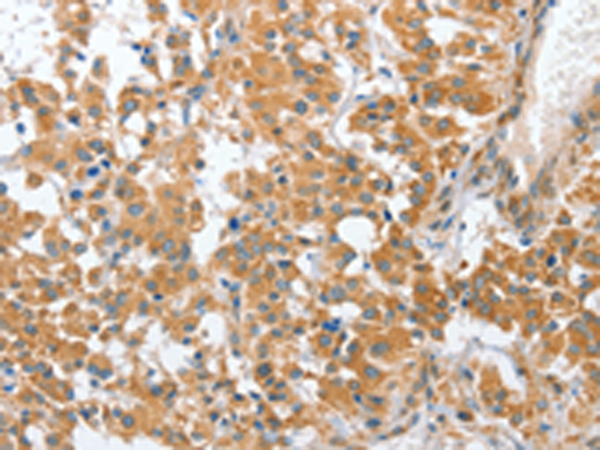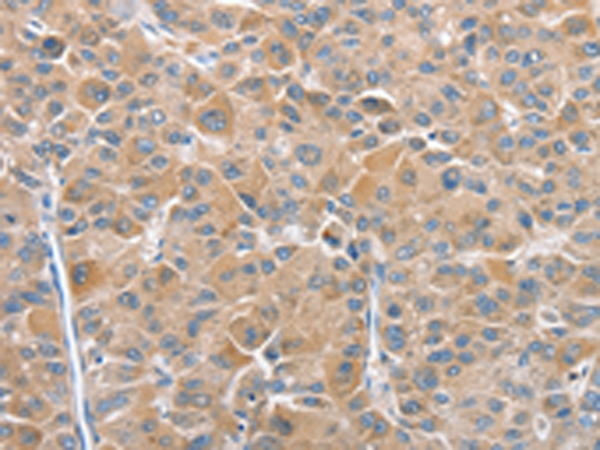

| WB | 咨询技术 | Human,Mouse,Rat |
| IF | 咨询技术 | Human,Mouse,Rat |
| IHC | 1/50-1/200 | Human,Mouse,Rat |
| ICC | 技术咨询 | Human,Mouse,Rat |
| FCM | 咨询技术 | Human,Mouse,Rat |
| Elisa | 1/2000-1/5000 | Human,Mouse,Rat |
| Aliases | SNF7; CTPP3; Shax1; CHMP4A; SNF7-2; VPS32B; CTRCT31; Vps32-2; C20orf178; dJ553F4.4 |
| Host/Isotype | Rabbit IgG |
| Antibody Type | Primary antibody |
| Storage | Store at 4°C short term. Aliquot and store at -20°C long term. Avoid freeze/thaw cycles. |
| Species Reactivity | Human, Mouse |
| Immunogen | Fusion protein of human CHMP4B |
| Formulation | Purified antibody in PBS with 0.05% sodium azide and 50% glycerol. |
+ +
以下是3篇关于CHMP4B抗体的参考文献,包含文献名称、作者及摘要概括:
---
1. **文献名称**: *"CHMP4B is required for efficient cytokinetic abscission and localizes to the midbody through its interaction with ALIX"*
**作者**: Morita E, et al. (2010)
**摘要**: 研究揭示了CHMP4B在细胞分裂末期膜切割中的作用,利用特异性抗体证实其通过与ALIX蛋白互作定位在中间体,并发现其功能缺失导致分裂失败。
---
2. **文献名称**: *"Mutations in CHMP4B cause autosomal dominant posterior polar cataracts"*
**作者**: Shiels A, et al. (2007)
**摘要**: 首次发现CHMP4B基因突变与人类后极性白内障相关,通过Western blot和免疫荧光技术(使用CHMP4B抗体)证明突变导致蛋白异常聚集,破坏晶状体细胞结构。
---
3. **文献名称**: *"ESCRT-III protein CHMP4B is upregulated in prostate cancer and regulates proliferation and apoptosis"*
**作者**: Lee YR, et al. (2015)
**摘要**: 发现前列腺癌中CHMP4B表达升高,利用抗体进行免疫组化分析,证实其通过调控细胞周期和凋亡信号通路促进肿瘤进展,提示其作为潜在治疗靶点。
---
**注**:如需具体文献链接或更多信息,可进一步通过PubMed或期刊官网检索上述标题。
The CHMP4B antibody is a crucial tool in studying the Charged Multivesicular Body Protein 4B (CHMP4B), a component of the Endosomal Sorting Complex Required for Transport (ESCRT)-III machinery. CHMP4B plays a vital role in membrane remodeling processes, including cytokinesis, multivesicular body (MVB) formation, viral budding, and repair of plasma membrane damage. As part of the ESCRT-III complex, it facilitates the scission of membrane necks in a ubiquitin-dependent manner, ensuring proper cell division, organelle biogenesis, and cellular homeostasis.
Antibodies targeting CHMP4B are widely used in research to investigate its expression, localization, and interactions in various cellular contexts. They enable detection through techniques like Western blotting, immunofluorescence, and immunohistochemistry. Dysregulation of CHMP4B has been implicated in diseases such as cancer, neurodegenerative disorders, and ciliopathies, making its study clinically relevant. For example, mutations in CHMP4B are linked to congenital cataracts and limb-girdle muscular dystrophy.
Researchers also utilize CHMP4B antibodies to explore ESCRT-III's role in HIV-1 release and other viral infections. These tools help unravel mechanisms underlying membrane dynamics and disease pathogenesis, highlighting CHMP4B's significance in both basic and translational biomedical research.
×